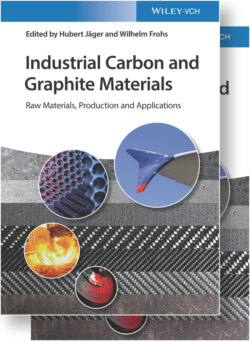Читать книгу Industrial Carbon and Graphite Materials - Группа авторов - Страница 268
6.1.1.1.4.3 Thermosetting Resins
ОглавлениеThermosetting resins (e.g. phenolics, furfuryl resin, epoxies, and polyurethanes) are another important group of precursors for the production of carbon materials. They are generally used as binder and adhesive to bond carbon particles, to enhance the strength of green bricks, to act as subsidiary carbon donor in addition to conventional carbon precursors (e.g. pitch or tar) [39, 40], and as impregnation agent without subsequent pyrolysis to reduce the gas permeability and enhance the strength of the final products (e.g. graphite tubes for heat exchanger applications).
Thermosetting resins, when used as carbon precursor, are generally used as liquids (e.g. impregnation), subsequently polymerized at moderate temperatures to form dimension‐stable green bricks, and finally pyrolyzed to form carbon materials. The thermosetting precursor materials undergo decomposition and reorientation during pyrolysis to generate polymeric carbon by condensation processes [41]. As these thermosetting polymers do not melt during pyrolysis, they produce a non‐graphitizable carbon (See Chapter 5.3 synthetic graphite Figure 5.7.). These amorphous carbon materials exhibit a mostly closed porous structure with a mean porosity of 20–30%. The possibilities to control the morphology are manifold. Aside from a chemical modification of the resin, a tuning of processing variables enables a product control to achieve the designated material performance (e.g. carbon yield, porosity, stability to oxidation, etc.). Parameters to influence the material performance, the processing, and pyrolysis behavior are the type of resin, its constitution, the cross‐linking density, temperature profile, and the pyrolysis atmosphere [42–46].
The most common resin systems applicable as thermosetting precursor for the production of carbon materials are phenolic resins and their derivatives. The major advantages of phenolics, in comparison with other thermosetting precursors, are their high carbon yields of up to 70%, being the highest values among the group of thermosetting resins (epoxy resins only up to 35%) and the good stability toward oxidation. In addition, the emission of organic cleavage products during the pyrolysis is considerably reduced and less problematic when compared with conventional precursor materials [43, 47]. Thus, the mentioned features make phenolic resins a favorable alternative carbon precursor, especially with regard to environmental aspects. However, even though phenolics are the cheapest resin systems among the group of thermosetting materials, the purchasing costs are much higher, and the carbon yields lower than for competing carbon precursors such as pitch or tar [48]. Thus, the applicability of thermosetting resins is presently limited to some special products, mainly for economic reasons [49]. Thermosetting resins can be carbonized without a filler component. The product is glass‐like carbon, which is mostly used in crucibles for dental applications. On the other hand, if combined with carbon fibers called carbon fiber reinforced polymers (CFRP) or if exposed to carbonization, so‐called carbon fiber reinforced carbon (CFRC) is obtained. This material is used in high‐temperature applications and in corrosive atmosphere. One well‐known application is in brake systems for airplanes and formula one racing cars. This CFRC can also be transferred into various ceramic systems via siliconization with different remaining shares of carbon, Si, and SiC according to the targeted application.
